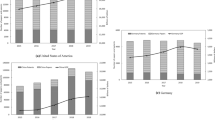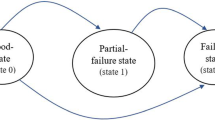Abstract
We study a \(\delta \) shock and wear model in which the system can fail due to the frequency of the shocks caused by external conditions, or aging and accumulated wear caused by intrinsic factors. The external shocks occur according to a Bernoulli process, i.e., the inter-arrival times between two consecutive shocks follow a geometric distribution. Once the system fails, it can be repaired immediately. If the system is not repairable in a pre-specific time D, it can be replaced by a new one to avoid the unnecessary expanses on repair. On the other hand, the system can also be replaced whenever its number of repairs exceeds N. Given that infinite operating and repair times are not commonly encountered in practical situations, both of these two random variables are supposed to obey general discrete distribution with finite support. Replacing the finite support renewal distributions with appropriate phase-type (PH) distributions and using the closure property associated with PH distribution, we formulate the maximum repair time replacement policy and obtain analytically the long-run average cost rate. Meanwhile, the optimal replacement policy is also numerically determined by implementing a two-dimensional-search process.


Similar content being viewed by others
References
Alfa AS (2004) Markov chain representations of discrete distributions applied to queueing models. Comput Oper Res 31:2365–2385
Alfa AS, Castro IT (2002) Discrete-time analysis of a repairable machine. J Appl Probab 39:503–516
Barlow RE, Hunter LC (1960) Optimum preventive maintenance policies. Oper Res 8:90–100
Block HW, Langberg NA, Savits TH (1993) Repair replacement policies. J Appl Probab 30:194–206
Boland PJ, Proschan F (1982) Periodic replacement with increasing minimal repair costs at failure. Oper Res 30:1183–1189
Castro IT, Pérez-Ocón R (2006) Reward optimization of a repairable system. Reliab Eng Syst Saf 91:311–319
Chien YH (2012) The effects of a free-repair warranty on the discrete-time periodic replacement policy. Int J Prod Econ 135:832–839
Eryilmaz S (2013) On the lifetime behavior of a discrete time shock model. J Comput Appl Math 237:384–388
Gut A, Hüsler J (1999) Extreme shock models. Extremes 2:295–307
Lam Y (1988) A note on the optimal replacement problem. Adv Appl Probab 20:479–482
Latouche G, Ramaswami V (1999) Introduction to Matrix Analytic Methods in Stochastic Modeling. SIAM, Philadelphia
Leung KNF (2006) A note on A bivariate optimal replacement policy for a repairable system. Eng Optim 38:621–625
Leung KNF, Zhang YL, Lai KK (2010) A bivariate optimal replacement policy for a cold standby repairable system with repair priority. Naval Res Logistics 57:149–158
Li ZH, Kong XB (2007) Life behavior of \(\delta \)-shock model. Stat Probab Lett 77:577–587
Nakagawa T (1979) A summary of block replacement policies. RAIRO Oper Res 13:351–361
Nakagawa T (1984) Optimal policy of continuous and discrete replacement with minimal repair at failure. Naval Res Logistics Q 31:543–550
Nakagawa T (2005) Maintenance Theory of Reliability. Springer, New York
Nakagawa T, Osaki S (1974) The optimum repair limit replacement policies. Oper Res Q 25:311–317
Neuts MF (1975) Probability distribution of phase type. In: Liber amicorum Prof. emeritus H. florin. Belgium: Department of Mathematics. University of Louvain, pp 173–206
Ross SM (1996) Stochastic processes, 2nd edn. Wiley, New York
Scarf PA, Deara M (2003) Block replacement policies for a two-component system with failure dependence. Naval Res Logistics 50:70–87
Shanthikumar JG, Sumita U (1984) Distribution properties of the system failure time in a general shock model. Adv Appl Probab 16:363–377
Sheu SH (1991) A generalized block replacement policy with minimal repair and general random repair costs for a multi-unit system. J Oper Res Soc 42:331–341
Sheu SH, Chien YH (2004) Optimal age-replacement policy of a system subject to shocks with random lead-time. Eur J Oper Res 159:132–144
Wang HZ, Pham H (2006) Reliability and optimal maintenance. Springer, New York
Wang GJ, Zhang YL (2007) An optimal replacement policy for a two-component series system assuming geometric process repair. Comput Math Appl 54:192–202
Wang GJ, Zhang YL (2009) A bivariate mixed policy for a simple repairable system based on preventive repair and failure repair. Appl Math Model 33:3354–3359
Wang GJ, Zhang YL (2013) Geometric process model for a single-unit system with limit repair time. J Southeast Univ 43:1335–1339 (in Chinese)
Xie M (1987) A shock model for software failures. Microelectron Reliab 27:717–724
Yeh RH, Chen MY, Lin CY (2007) Optimal periodic replacement policy for repairable products under free-repair warranty. Eur J Oper Res 176:1678–1686
Yu MM, Tang YH, Liu LP, Cheng J (2013) A phase-type geometric process repair model with spare device procurement and repairmans multiple vacations. Eur J Oper Res 225:310–323
Zhang YL (1994) A bivariate optimal replacement policy for a repairable system. J Appl Probab 31:1123–1127
Zhang YL, Wang GJ (2009) A geometric process repair model for a repairable cold standby system with priority in use and repair. Reliab Eng Syst Saf 94:1787–1789
Acknowledgments
The authors would like to thank the anonymous reviewers for their valuable comments and suggestions to improve the quality of this paper. This research was partially supported by National Natural Science Foundation of China (Nos. 71301111, 71571127, 71402072) and the FSUSE (No. 2012RC23).
Author information
Authors and Affiliations
Corresponding author
Rights and permissions
About this article
Cite this article
Yu, M., Tang, Y. Optimal replacement policy based on maximum repair time for a random shock and wear model. TOP 25, 80–94 (2017). https://doi.org/10.1007/s11750-016-0417-0
Received:
Accepted:
Published:
Issue Date:
DOI: https://doi.org/10.1007/s11750-016-0417-0
Keywords
- Phase-type distribution
- Finite support
- \(\delta \) shock and wear model
- Maximum repair time
- Average cost rate




